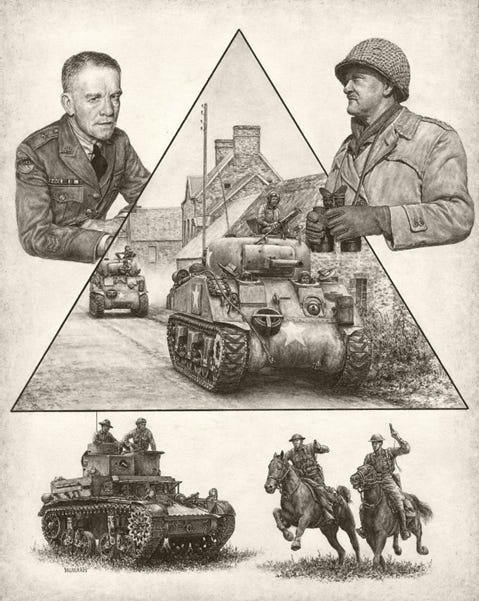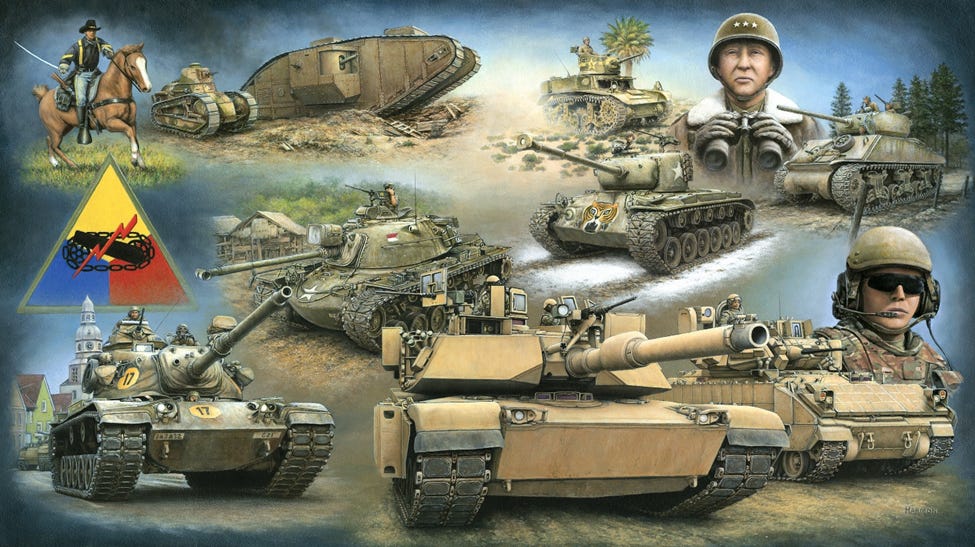Throwback Thursday
Get comfortable and take a seat while you enjoy a short history lesson of ARMOR Magazine.
In 1888, 2LT Fredrick S. Foltz contributed the first article in the Journal of the United States Cavalry Association titled, “Some German Ideas on Cavalry Gathered From Conversations on Cavalry.” This 17-page article marks the beginning of 137 years of continuous publication spanning over 690 editions. The purpose was simple but ambitious: to debate ideas, share lessons, and connect across the force. The Army was scattered across remote outposts, but these officers were thinking ahead. They knew that a branch needed more than tactics and training. It needed a voice.
That voice endured through the transition from horse to steel. What began in 1888 as The Cavalry Journal became The Armored Cavalry Journal in 1947, reflecting the Army’s shift toward mechanized warfare. In 1950, the publication was reintroduced as ARMOR under the Cavalry and Armor Association, symbolizing the union of cavalry tradition with armored warfare. In 1974, ARMOR separated from The Association and came under the U.S. Armor School, where it established a consistent quarterly rhythm. What started as a forum for horsemen matured into a professional bulletin dedicated to the development of Armor Soldiers and leaders. Its story mirrors that of the tank itself that is born from necessity, refined by experience, and always ready for the next battlefield.
The Tank’s Many “Deaths”
If you’ve been in uniform long enough, you’ve probably heard someone say the tank is dead. Too heavy. Too slow. Too vulnerable. Some potential threat, enter (____________), will finally put the armored force out of its misery. The problem is, this obituary has been written before. Just like Michael Meyers in Halloween, the tank refuses to stay down.
That’s what struck me when I read a 1952 ARMOR article by historian Richard Ogorkiewicz. Shortly after World War II, he laid out “The Ten Ages of Tank” and showed how the armored force has never stopped evolving. Seventy years later, the words are still relevant. The tank’s story is not about obsolescence, but one of constant reinvention.
The First Age: Trenches and Steel
Cold and wet. Deep, mud-filled trenches. Barbed wire. Machine guns. This paints the scene for the conditions and obstacles during World War I that froze armies in place. Out of desperation the tank was born. The first tanks - the British MK 1 fielded in 1916 and the French Renault FT fielded in 1917 - were slow, prone to breakdown, and terrified their own crews. However, they managed to do what no other weapon system had been able - they crushed the wire, spanned the trenches, and carried the infantry forward through no man’s land. It was the first age of armor, but it proved the tank’s utility in the stalemate of war.
And yet, after WWI, the tank was no longer useful. The tank was dead.
Ages two through five marked the tank’s transformation from an experimental weapon into the backbone of modern armies. Across these decades, design, doctrine, and industry converged to turn armored warfare into a science, setting the stage for the lightning tactics and sweeping offensives that would soon define the sixth age of Blitzkrieg.
Shock and Awe: The Blitzkrieg Lesson
Ogorkiewicz’s sixth age highlighted the German Blitzkrieg during WWII. Tanks became fast and decisive, expanding beyond being merely an infantry support vehicle, now evolved to serve as the tip of the spear. Maneuverablity, speed, and overwhelming firepower allowed the German Army to quickly seize the initiatives in Poland and France. The U.S. Army learned quickly. By combining armor with artillery, engineers, and airpower, we created the combined arms fight that that is still a focal point of our doctrine. As a former Maneuver Captain’s Career Course instructor, I know future company commanders must understand this lesson. Tanks alone do not win battles, but tanks can change the tides of war when integrated into the larger fight.
Despite the successes of WWII, the tank was once again declared dead.
The Modern Ages
Post-war eras brought about massed U.S. Armor formations stationed across the plains of Europe, poised to face the Soviet Union. In fact, thousands of tanks were expected to clash in decisive battles. For the tenth age of the tank, Ogorkiewicz focused his attention on the future where he rightly predicted advances in firepower, survivability, and speed. He could not have foreseen the Abrams or Leopard 2, but he was able to anticipate that tanks would adapt to future warfare by way of increases to the protection, maneuverability, and lethality.
Even after Vietnam and Desert Storm, conflicts that prompted many to declare the death of the tank, yet Ogorkiewicz’s analysis shows that the tank is far from dead. In fact, it continues evolving to meet the demands of the modern battlefields.
Hilarious photo courtesy of author.
Why Tanks Still Matter
Skeptics say the tank’s days are numbered. They always have. Some believe new platforms or weapons will outpace the armored force. Yet, history tells a different story! Tanks survive because they never stand still. More specifically, the tanks survival comes from constant change. Tanks remain relevant because they can adapt to the battlefield rather than be overtaken by it.
What is ARMOR up to today?
ARMOR is nothing without its contributors. It is not meant to be a top-down mechanism. ARMOR serves as a living embodiment of the Armor Branch, and its value directly relates to the contributions from Soldiers within the branch. ARMOR invites everyone to contribute, from the young, enlisted Soldier, up to and including General Officers. These contributions have allowed the magazine to maintain its relevancy for generations.
Much like its readers, ARMOR has also embraced going digital. Today, quarterly digital issues are available on the eArmor. The move to digital means that every Tanker, Trooper, or Soldier can read the professional bulletin whether they are local to Fort Benning, on a deployment, or training across the force. The digital platform has brought the magazine to a wider audience and given us a better sense of what readers connect with, topping more than 22,000 views in the last two issues. For those who still value the feel of a printed page, a special fall edition continues that tradition each year.
For the Army as a whole, ARMOR is more than a branch journal. When Soldiers write, debate, and share experiences, they make themselves and the force stronger. What ARMOR has shown after five hundred editions is that even though mounted warfare may change on the battlefield, the need to think, challenge and write never goes away.
Final Stable Call!
ARMOR magazine is not just an archive. It is a means of driving forward and building the future of the Armor Branch. The tank survives because it evolves, and over a century later, our journal is no different. It thrives on the voices of those willing to write. If you want the Armor force to stay sharp, relevant, and ready, then answer the call! Contribute. Have discourse. Challenge. This is how we carry the branch forward. As the Armor Harding Fellow, I look forward to working with every Soldier who has a story, idea, or lesson to share in ARMOR magazine.
CPT Nate Green is currently serving as the Armor Harding Fellow for the Office of the Chief of Armor at Fort Benning, GA. CPT Green is an Armor officer and holds a bachelor’s in Engineering Management from the U.S. Military Academy, and currently earning a master’s in business administration from the University of Georgia.
Additional editing contribution by Robert Ositis and 1LT Kaden Schmittner.






An outstanding article that captures many key concepts about the evolution of the tank. We recently completed a study about the future of armored warfare and came up with many of the same conclusions. The tank is not dead and most likely will not die any time soon. However, its role will continue to evolve and so will its relationship to the other weapons on the battlefield.
One idea that we came up with was that the "Tank Destroyer" (TD) of WWII (which ultimately proved to be flawed concept at the time) may find new life with the help of modern sensors and technologies. Military leaders like Lesley McNair envisioned tanks and TDs fighting as part of a combined arms force on the WWII battlefield. One way to increase the survivability of traditional tanks on the modern battlefield might be introducing specialized TD formations into the armored force. These modern TDs would be cheap, small, highly mobile, equipped with a range of ATGMs and drones (allowing for beyond-line-of-sight attack) and could operate both manned and unmanned.
However, modern TDs won't just kill tanks. They could kill drones as well. The same vehicle chassis could be designed for modular conversion into a counter-UAS (CUAS) platform, or EW platform etc. addressing other vulnerabilities and capabilities gaps in our current armored MTOE. Such vehicles could potentially clear a path or act as a screen in front of armored formations, similar to the way Wild Weasel (SEAD) and EW aircraft protected strike aircraft from SAMs in Vietnam and subsequent wars.